#monopodies
Text

Amesiella monticola 🏵🌱
Very compact monopodial species from the Philippines. The flower is fragrant
9 notes
·
View notes
Text
Tumbuhan Berbiji Dikotil dan Ciri Ciri Anatominya
Tumbuhan Berbiji Dikotil dan Ciri Ciri Anatominya – Angiospermae, tumbuhan yang tergolong dalam anak divisi ini berupa pohon-pepohonan, semak-semak maupun terna dengan batang yang bercabang monopodial atau simpodial. Berkas pengangkutan kolateral terbuka atau tertutup. Ada pula yang bokolateral, dalam akar selalu radikal. Dalam xilem selalu terdapat trakea dan trakeida. Batang dapat menunjukkan…

View On WordPress
0 notes
Text
Buy Clumping Bamboo From A Licensed Plant Nursery 407-777-4807 Ocoee Banboo Farm - Running Bamboo Vs Clumping Bamboo - When choosing bamboo for your garden or landscape, it is generally recommended to select clumping bamboo rather than running bamboo. Here are a few reasons why:
* Growth behavior: Clumping bamboo (sympodial) grows in a clumping or spreading manner, with new shoots emerging close to the main plant. Running bamboo (monopodial), on the other hand, spreads through underground rhizomes, allowing it to potentially invade other areas of your garden. Running bamboo can be quite aggressive and difficult to contain, requiring extensive root barriers or constant maintenance to prevent it from spreading uncontrollably.
* Containment: Clumping bamboo is generally easier to contain and maintain. Its growth habit allows you to create well-defined borders or barriers to limit its spread. This makes it more suitable for smaller gardens or areas where you want to keep the bamboo confined to a specific space.
* Maintenance: Running bamboo often requires more maintenance to control its spread. If left unchecked, it can quickly take over large areas and become difficult to remove. This can be time-consuming and labor-intensive, especially if it encroaches on other plants or structures in your garden. Clumping bamboo, on the other hand, requires less maintenance and is generally easier to manage.
* Variety options: Clumping bamboo offers a wide variety of species and cultivars to choose from, each with its own unique characteristics and appearances. This allows you to select the specific type of bamboo that suits your needs and preferences. Running bamboo, while also available in various types, may have limitations due to its invasive nature.
* Reputable sources: it is important to purchase bamboo from reputable sources like Ocoee Bamboo Farm 407-777-4807
#runningbamboo#running#clumping#clumpingbambooorlando#clumpingbamboohedge#clumpingbamboovariety#clumpingbamboos#clumpingbambooshoots#clumpingbamboo#floridaplants#floridahouses#newconstruction#newhouse#backyards#backyardideas#backyardfence#bamboo#privacy#orlando#bamboonursery#gracefulbamboo#jacksonville#backyard#florida#tampa
0 notes
Text
Orquídea-abacaxi (Robiquetia cerina) - Família Orchidaceae
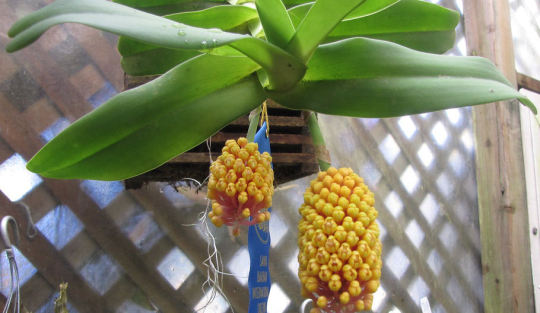
Nome Científico: Robiquetia cerina
Nomes Populares: Orquídea-abacaxi, Abacaxizinho
Família: Orchidaceae
Categoria: Flores, Orquídeas
Clima: Equatorial, Oceânico, Tropical
Origem: Ásia, Filipinas, Nova Guiné, Oceania
Altura: 0.4 a 1 metro
Luminosidade: Luz Filtrada
Ciclo de Vida: Perene
Orquídea-abacaxi (Robiquetia cerina) - espécie muito exótica originária das Filipinas, produz um interessante cacho com várias flores!
As orquídeas são apaixonantes e conquistam diariamente novos admiradores. E não é difícil entender o motivo.
São plantas muito especiais que fazem a alegria de coleccionadores e cultivadores domésticos que se aventuram a cuidar das mais diversas espécies.
O nome do género, Robiquetia, é uma homenagem ao farmacêutico francês Pierre Jean Robiquet (1780 – 1840), conhecido por ter isolado a cafeína e sintetizado a codeína.
Já o nome da espécie, cerina, é o termo em latim para “de aspecto de cera”, uma alusão à textura das flores.
As suas folhas são de formato alongado, são esverdeadas e possuem espinhos nas bordas. Os frutos do abacaxi ornamental são de cor vermelha.
Porém existem espécies que possuem folhas com cores e tonalidades diferentes.
A Robiquetia cerina é uma orquídea natural, de crescimento monopodial, originária das Filipinas e Papua Nova Guiné.
Ela cresce sobre as árvores na maioria das vezes, e ocasionalmente é encontrada como rupícola (cresce sobre rochas).
Como cuidar da Orquídea-abacaxi
A orquidea-abacaxi necessita ser regada de maneira regular, além de ser uma planta que não se adapta e por isso não aceita o frio e as geadas.
O ideal é que na hora de fazer qualquer manipulação nesta planta, utilize luvas de preferência com textura grossa, para evitar ferimentos, pois as folhas possuem espinhos.
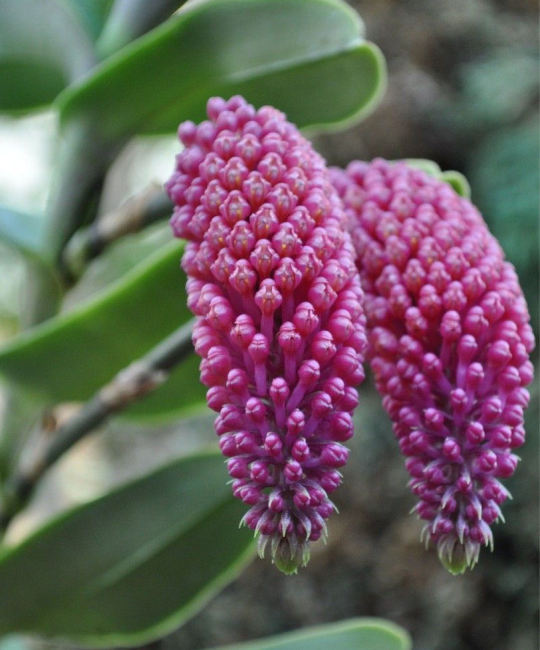
Como todas as vandáceas, cultive a Robiquetia cerina de forma suspensa, assim preserva o seu sistema radicular, e não se danifica a inflorescência pendente.
A Orquídea-abacaxi necessita de muita humidade atmosférica e regas abundantes das raízes, porém a drenagem deverá ser rápida e a ventilação boa, para se evitar problemas de apodrecimento de raízes e doenças por fungos.
Deve proteger a Orquídea-abacaxi nos dias mais frios do inverno.

Floresce no fim do verão e a sua floração dura em média três semanas.
Esta planta tem aspectos morfológicos muito diferentes de outras orquídeas.
Vandácea com ramos pendentes e longos, com folhas elípticas, florescendo em hastes pendentes de aproximadamente 10cm de comprimento.
Suportam dezenas de pequenas flores de diâmetro entre 0,5 e 0,8cm, que abrem em sucessão.
Quantidade de flores - cachos com mais de 50 flores.
A densa inflorescência lembra um abacaxi. Existem duas variedades, uma com as flores vermelhas e outra com flores amarelas.
Recomenda-se a adubação foliar semanal durante a primavera e verão com uma solução de 2g (1 colher de café) de adubo NPK Peter’s na proporção 20-20-20, para cada litro de água.
No outono e inverno a adubação da Orquídea-abacaxi pode ser a cada duas semanas. Faça também a adubação orgânica do substrato uma vez por mês.
https://youtu.be/89BrzRKrKeE
Curiosidades: as espécies do género Robiquetia possuem crescimento monopodial, ou seja, possuem um crescimento único e continuo.
Por isso tem um crescimento mais lento, porém são plantas que podem florescer mais de uma vez por ano e chegar a um comprimento de mais de um metro.
Read the full article
1 note
·
View note
Text
BERKUALITAS ! CALL! 0811-2914-187 Jual Bibit Anggrek Terdekat
Klik https://wa.me/628112914187 Tanaman Anggrek Dengan Pohon Mangga, Tanaman Anggrek Di Dinding, Tanaman Anggrek Dalam Rumah, Tanaman Anggrek Ekor Tupai, Tanaman Anggrek Gantung
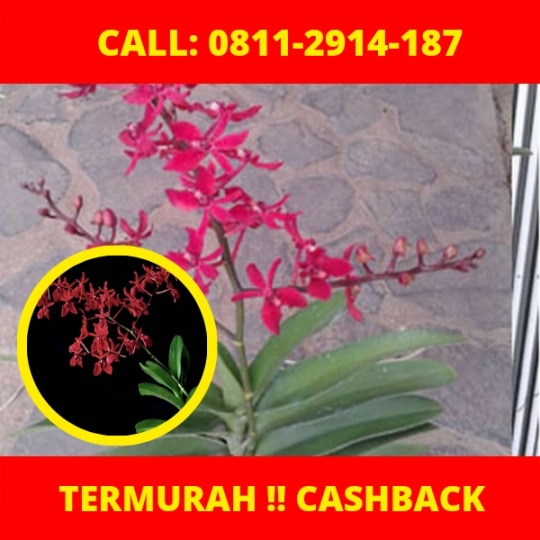
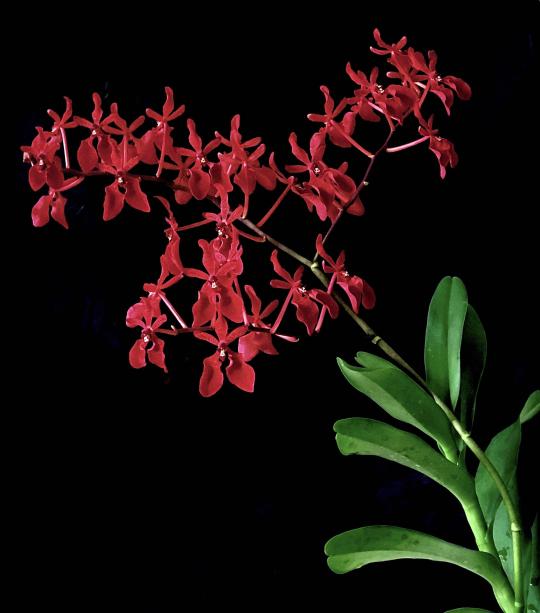
Renanthera, disingkat Ren dalam perdagangan hortikultura, adalah genus spesies anggrek epifit dan terestrial monopodial besar yang ditemukan di Cina, Himalaya, Asia Tenggara, Nugini, dan Melanesia.


Lestari Berkah TaniPelalangan Rt 06/01 PurwosariKec.Puring, Kab.KebumenJawa Tengah 54383Patokan : Belakang Balai Desa Purwosari mentok kemudian belok ke barat sampai ada pelawangan durian di kanan jalan.Contact : Whatsapp : 0811-2914-187No Tlp : 0811-2914-187SMS : 0811-2914-187Web : Bibit Anggur : www.jualbibitanggurimport.comBibit Durian : www.jualbibitdurian.comBibit Musangking : www.bibitdurianmusangking.comBibit Kelengkeng : www.jualbibitkelengkeng.comLinktree : https://linktr.ee/jualbibitanggursiapbuahTiktok : https://vt.tiktok.com/ZSdgg8gK8/
#bibitanggrekjatim#bibitanggrekjember#bibitanggrekjombang#bibitanggrekjawatimur#bibitanggrekjawatengah#bibitanggrekkwb#bibitanggrekkuning#bibitanggrekkotabatu#bibitanggreklampung#bibitanggreklangka
0 notes
Text


Two phalaenopsis orchids I picked up for 40% off yesterday. They’re labeled as miniatures and were miniature price even without the sale, but they’re actually a nice medium size.
33 notes
·
View notes
Text



I got a phalaenopsis, a vanda 'pachara blue' seedling, and a begonia!
#the vanda will take years to get to flowering size but the flowers it will have are absolutely stunning#tara.txt#plant update#im not a monopodial person usually but im in love with my phals at the moment and im interested to see how ill go with a vanda
3 notes
·
View notes
Photo

#habenaria #groundorchid #reinorchids #bogorchids #orchidaceae #deciduousorchids #fleshytuberers #monopodial #terrestrialorchid #riddhi #perinial #gardenstories #banglore #runwithkiran #horticulturist #orchidstories #pixelclicks #mobilephotography #instagram #horti #flowerphotography #gardening (at Bangalore, India) https://www.instagram.com/p/CSo017hHxJc/?utm_medium=tumblr
#habenaria#groundorchid#reinorchids#bogorchids#orchidaceae#deciduousorchids#fleshytuberers#monopodial#terrestrialorchid#riddhi#perinial#gardenstories#banglore#runwithkiran#horticulturist#orchidstories#pixelclicks#mobilephotography#instagram#horti#flowerphotography#gardening
1 note
·
View note
Text

Phalaenopsis Orchid 🌸🌱
also known as moth orchids, is a genus of about seventy species of plants in the family Orchidaceae. Orchids in this genus are monopodial epiphytes or lithophytes with long, coarse roots, short, leafy stems and long-lasting, flat flowers arranged in a flowering stem that often branches near the end.
9 notes
·
View notes
Text
Orchid population
With more than 30,000 species of orchid in over 800 genera, its natural habit of many species is in the tropics where the majority of the species grow on the trunks and branches of trees for support. In the temperate zones, such as Southern Australia, the flower orchid grows mostly on the ground.

There are two growth types of orchids: The first, known as Monopodial Orchids, have a central stem of growth and no pseudo bulbs; they produce new growth from the crown of the plant, and flowers are produced from the stem between the leaves.
The second known as Symbodial Orchids possess a rhizome which sends out a shoot. This develops into a stem and leaves and eventually produces flowers. Later, a new shoot develops from the base of this growth.
source - theflowerexpert.com
0 notes
Text
Besides having been considered a personification of the White Crown, the Egyptians regarded Osiris as the personified spirit of barley; for example, the Coffin Texts quote Osiris as saying, “I am Osiris ... I am barley ...” (de Buck, 1947). Osiris therefore appears in Fig. 18 covered by and shedding the barley he personified with the Atef or Osiris crown, comprising the White Crown flanked by feathers, literally growing from his head, just as Cheops and the Magicians explains allegorically how the White Crown grew from the stored barley.
Osiris was therefore typically depicted monopodially [one-legged] with arms akimbo (Fig. 19, left), obviously so he would look remarkably like a mushroom (Fig. 19, right), especially to anyone who was privileged to the esoteric information that Osiris’s original nature was mycological. In fact, because the practice of personifying mushrooms as monopodial beings was widespread in antiquity, mummies were apparently fashioned with a single or fused legs and arms akimbo to look like mushrooms, as explained more below vis a vis the tekenu.
Stephen Berlant, The entheomycological origin of Egyptian crowns and the esoteric underpinnings of Egyptian religion
#quote#Stephen Berlant#The entheomycological origin of Egyptian crowns and the esoteric underpinnings of Egyptian religion#entheomycology#ethnobotany#Osiris#Ancient Egypt#Egypt#Kemeticism#mycology#Cheops and the Magicians#psilocybe cubensis
29 notes
·
View notes
Text
Anggrek Bulan, Si Cantik Puspa Pesona
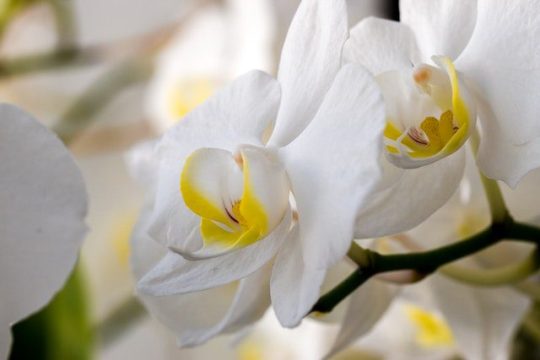
Tanaman hias bunga anggrek bulan merupakansalah satu tanaman bunga yang cukup populer di Indonesia. Tak heran bunga yang juga menjadi salah satu bunga nasional ini memiliki bunga yang sangat cantik, sehingga banyak menjadi pilihan para penggemar tanaman bunga untuk mengisi pot bunga sebagai tanaman hias di halaman rumah. Penasaran dengan bunga yang cantik ini? Jangan sampai terlewat karena Flora Fauna Indonesia kali ini akan membahas secara lengkap si cantik puspa pesona ini dari ciri-ciri sampai jenis bunga anggrek bulan. Yuk simak sampai habis..
Estimasi waktu baca: 5 menit
Anggrek bulan adalah salah satu tanaman bunga yang ditetapkan melalui keppres RI No.4 tahun 1993 tentang satwa dan bunga nasional sebagai bunga nasional (puspa pesona). Bunga ini ditetapkan sebagai bunga nasional bersama 2 (dua) bunga lainnya yaitu melati putih dan padma raksasa (rafflesia arnoldii). Tanaman hias berbunga ini sering kita jumpai sebagai tanaman hias di halaman rumah, tak heran karena tanaman bunga anggrek bulan mempunyai bunga yang sangat indah selain itu juga bunga anggrek bulan mempunyai banyak sekali variasi warna bunga yang akan membuat halaman rumah semakin semarak dan menyejukkan mata ketika memandangnya.
Kenal Lebih dekat anggrek bulan
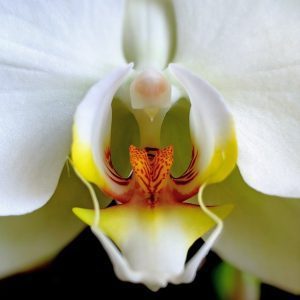
Phalaenopsis amabilis (pexels.com)
Anggrek bulan (phalaenopsis amabilis) yang dalam bahasa Inggris dikenal moon orchid adalah salah satu jenis dari sekian banyak jenis bunga anggrek. Dalam pengklasifikasian bunga di golongkan ke dalam famili Orchidaceae.
Anggrek bulan ditemukan pertama kali oleh ahli botani bernama Dr. C.L. Blume yang berasal dari Belanda. Bunga ini hidup dengan cara epifit dan litofit meskipun sangat jarang. Epifit adalah tanaman yang "menumpang" dan menempel di tanaman lain sebagai inangnya. Berbeda dengan parasit yang merugikan karena menyerap nutrisi dari tanaman inangnya, epifit tidaklah merugikan tanaman inangnya. Sedangkan litofit serupa dengan epifit hanya saja yang ditumpanginya bukanlah tanaman lain melainkan batu dan tanah berbatu.
Taksonomi
Ciri-ciri bunga anggrek bulan
https://youtu.be/EOEZ9Nc_zLY
moth orchid (Phalaenopsis) by NCSU Edibles youtube channel
Bunga anggrek bulan (phalaenopsis amabilis) memiliki bunga yang sangat indah. Bunganya biasanya tersusun dengan rapi di tangkai bunga yang tumbuh dari batang tanaman ketika akan berbunga. Tangkai bunga pada umumnya memiliki panjang tangkai + 30 cm - 75 cm yang kaku dan tumbuh melengkung. Dalam satu tangkai akan tumbuh bunga sebanyak 2 - 10 bunga yang akan bertahan cukup lama sebelum akhirnya layu dan rontok. Bunganya memiliki panjang 6 - 7 cm dengan lebar 5-8 cm dengan sepal dan petal (kelopak) yang menyebar berjauhan dari satu dengan yang lainnya. Sepal berbentuk menyerupai telur dengan panjang 3-4 cm, dengan lebar + 2 cm. Sedangkan kelopak bunga juga berbentuk menyerupa telur hingga persegi dengan panjang dan lebar 3-4 cm. Labelum berwarna putih dengan corak kuning dan kemerahan dengan panjang 2,5 cm serta terdapat lobus 3 lobus di tengahnya.
Puspa pesona mempunyai tinggi sekitar 10 - 30 cm dengan batang yang hampir tertutupi oleh daunnya. Sedangkan panjang akarnya yang berwarna putih dapat mencapai lebih dari 1 m, tergantung kondisi dan lingkungan.
Habitat
Bunga anggrek bulan merupakan tanaman bunga yang tersebar luas dari Indonesia, Filipina, Malaysia, dan Australia. Bunga ini umumnya tumbuh di atas-atas pohon (epifit) dan di bebatuan (litofit) di hutan hujan tropis yang mempunyai kelembaban cukup tinggi. Tanaman bunga ini merupakan bunga monopodial yang tumbuh subur di dengan cahaya matahari yang relatif sedikit dengan ketinggian hingga 600 mdpl (meter di atas permukaan laut).
Jenis-jenis anggrek bulan

Phalaenopsis amabilis (pixabay.com)
Saat ini banyak sekali jenis anggrek bulan yang dijual dipasaran dan ditanam sebagai tanaman bunga hias. Sebagian besar yang sering kita temui adalah hasil hibridisasi yang merupakan hasil perkawinan silang antar spesies anggrek bulan. Jenis-jenis anggrek bulan yang sering kita temui dibedakan berdasarkan warna, corak dan totol-totol pada bunganya. Namun ada 3 jenis (sub spesies) anggrek bulan menurut World Checklist of Selected Plant Families :
- Phalaenopsis amabilis subsp. amabilis, ini adalah jenis yang paling sering, mudah ditemui dan banyak dijual dipasaran. Jenis ini memiliki lubus tengah yang berbentung salib dengan corak kuning dan kemerahan.
- Phalaenopsis amabilis subsp. moluccana, jenis ini memiliki lobus tengah yang berbentuk lonjong dan sedikit lebar di bagian pangkal lobus dengan corak kuning dan putih.
- Phalaenopsis amabilis subsp. rosenstromii, jenis ini memiliki lobus tengah yang berbentuk segitiga dan relatif pendek serta corak berwana kuning.
Nah itulah semua hal yang perlu kamu tahu tentang anggrek bulan, dari ciri-ciri bunga sampai jenis-jenis nya. Terima kasih sudah berkunjung, semoga bermanfaat.
+ LIHAT REFERENSI
en.wikipedia
Read the full article
1 note
·
View note
Text
HARGA TERJANGKAU ! CALL! 0811-2914-187 Jual Bibit Anggrek Kultur Jaringan
Klik https://wa.me/628112914187 Bibit Anggrek Bulan Remaja, Bibit Anggrek Bulan Taiwan Botolan, Bibit Anggrek Cattleya, Bibit Anggrek Cangkok, Bibit Anggrek Dendrobium


Anggrek Vanda adalah angrek monopodial (anggrek yang batang utamanya tumbuh terus-menerus ke atas tanpa batas) yang hidup di daerah tropis atau subtropis dan merupakan jenis anggrek yang mudah dirawat.


Lestari Berkah TaniPelalangan Rt 06/01 PurwosariKec.Puring, Kab.KebumenJawa Tengah 54383Patokan : Belakang Balai Desa Purwosari mentok kemudian belok ke barat sampai ada pelawangan durian di kanan jalan.Contact : Whatsapp : 0811-2914-187No Tlp : 0811-2914-187SMS : 0811-2914-187Web : Bibit Anggur : www.jualbibitanggurimport.comBibit Durian : www.jualbibitdurian.comBibit Musangking : www.bibitdurianmusangking.comBibit Kelengkeng : www.jualbibitkelengkeng.comLinktree : https://linktr.ee/jualbibitanggursiapbuahTiktok : https://vt.tiktok.com/ZSdgg8gK8/
#bibitanggrekaceh#bibitanggrekbandung#bibitanggrekbotolan#bibitanggrekbogor#bibitanggrekbulanmalang#bibitanggrekbulanmurah#bibitanggrekcikarang#bibitanggrekcymbidium
0 notes
Photo


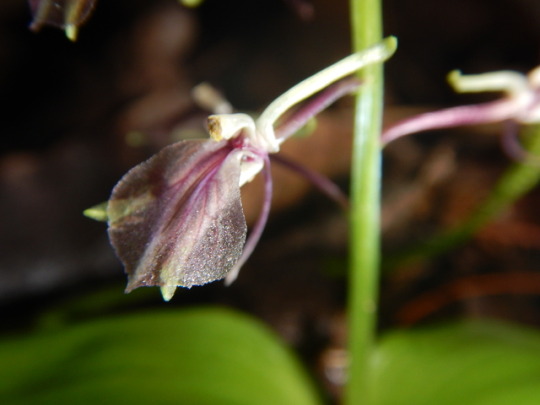

The Abyss of Diversity, an Ecological Mess, and A Potential First Step to Fixing It and Opening the Door to A Plethora of Information.
One plant family, above all others, from the monocot group is responsible for the largest removal of plant blindness than any other family. It’s a craze of love and sometimes even addiction. It can even cause ecological disasters from how far we take things with these monocots.
When one walks into a grocery store you may occasionally notice the orchids in floral section and become the casual observer. Or you may have gone to a conservatory/greenhouse and observed some orchids as you were enjoying the flora. You most likely associated the idea of an orchid flower with something relatively showy with glossy leaves and you may have even noticed that floral diversity with orchids are all across the board. This observation is a good observation as the orchid family, Orchidaceae, has incredible floral diversity, from showy to inconspicuous, caused by nearly every evolutionary pressure you can imagine.
The evolutionary subsets that involve coevolution could take hundreds of lifetimes to even scratch the surface of what could be known. Fungal experts, cell biologists, biochemical specialists, and ecological and evolutionary ecologists are just a small group of people that sometimes get stuck specializing in a single species discourse and they aren’t even botanists.
Besides the intensely frigid zones of the planet/ oceans, you can observe orchids in almost every other environment. For example: Eulophia petersii grows in the arid to semi arid regions of Southern Africa where it can experience what would normally seem like extreme bouts of drought and do well. Orchidaceae is also considered to be the largest current family(20k natural sp. with 100hybrid cv. being developed daily.) and the second largest natural family. We see new species discovered almost yearly; with this said, a very important notion of their diversity goes unnoticed by many people on a daily basis that should be just as celebrated as their floral/vegetative/ and niche diversity. What I am suggesting is something that can be a little matted down or even underground to what we readily observe. Its what makes the family possible to begin with; what I mean is the roots(pun intended). From macro-morphology to ultrastructural morphology the roots of orchids can be insanely unique and very important.
How deep does the diversity go? Aside from primary shape, location and function of orchid roots; the diversity of associated Mycorrhiza coupled with unique root bacteria available within’ and outside of the root may seem almost unfathomable when looking at extremely active and diverse ecosystems. The interactions and ecology between each species present is even more unreachable. It doesn’t help that transplanting species is in large enough numbers is impossible and ecologically damaging/ unethical. It seems like our only method for growing orchids in bulk involves our species of interest being either a seed-agar flask or a root-parenchyma tissue culture flask from very sterile lab conditions, the average person without these methods has to rely on potential divisions or kiki to even get anywhere. With these methods you can’t get a full story at all and it feels like an untouchable issue; however, this untouchable issue is beginning to be resolved in some cases.
First, before I go any further in what I am about to attempt to explain, I’d like to introduce some functional/common morphology and introduction before a break away into resolving the issue mentioned above.
Orchids are highly specialized, as I mentioned above, and so are their components. Just like many other organisms, survival and fitness are the prime focus and getting to disjunct populations and travelling is necessary to find suitable habitat. The majority of Orchid species, like any other large family on the planet, have evolved multiple ways of moving their seeds from location to location. The most common way to move seeds is to have wind dispersal as the primary mechanism. We see this, wind dispersal, as a major component with other large, wide spread families( Asteraceae, Poaceae, Cyprussaceae). Orchids have also found success in resource allocation, remove the nutrient layer of endosperm, make seeds airborn by flattening them and making them small enough to be carried on the breeze or birds wings, and because endosperm takes energy and is no longer being used it’ll go to seed numbers. The only issue is that when a seed lands with know tissue dedicated to primary germination, how will it grow? The simple truth is having chemical signalling and thin seed coat prone to fungal interactions. Orchids spread seeds during periods that promote the hydroponic soil surfaces to be inundated with water and motile oospores. Oospores can change direction based on chemical signalling, once these ambient Oospores are produced they will travel to these seeds and embed through the thin coat into the initial cells. At first, in many cases, these seeds are specifically useless to the fungi that have attached; but, in many cases, eventually symbiotic interaction will be established along with the initiation of photosynthesis. I say “in many cases” because, we do have our sections of mycoheterotrophs that essentially feed off of saprotrophic and heterotrophic fungi( Some coral roots exhibit this as a function.). Little is known at the moment about these chemical signals and more fungal allocation in primary germination seems to be associated with what is ambient. We see ambient germination in epiphytic members of orchidaceae often, some require dual specialized fungal associations, fungus associations with australian ferns and Arachnorchis behrii is an example of this. Either way the reliance of fungal interactions is key in primary germination outside of in-vitro- asymbiotic flasking environments. Once embedded or coated, depending on specificity (arbuscular-endo-mycosymbiont or exo-mycosymbiont), we get different forming protocorms in each species.
What is a protocorm? It is a pre-functioning seedling that begins secondary sell differentiation in a protected environment, creating organs while relying on another organism for aid in survival essentially. Once enough symbiotic associations are finalized, or somewhat finalized, and organ growth is past it’s primary stage while conditions are right, the protocorm will form what we know as the functional orchid. This means that roots and some form of energy storage organ are functioning. In some cases, we see just thickened roots as a main storage source and functional unit, corkscrew/ghost and coralloides are examples. Other species are divided into colloquial groupings, such as polypoidal -many feet and monopodial- single foot orchids. The polypoidal groupings are usually rhizomatous or have a thickened stollon where we se monopodial groupings with canes( elongate thickened stem like organs) or pseudobulbs (stout/bulb like thickened leaf meristem topped organs that are more closely associated with a traditional stem.) These obviously are not the limit to the storage diversity by any means, as storage cells can form a number of specialized organs. Valemen layer, the outermost sheathing layer of most orchid roots that are found briefly behind the root tip, can contain enlarged sink cells for water storage although the layers primary task is water absorption and protecting the photosynthetic root layer beneath and with terrestrials it can add a layer of security to its fungal and bacterial symbionts. Many times if need be, plants, without a proper long term storage organ, may revert pack to a protocorm state until good conditions and less soil compaction are a transparent factor in the environment; this concept explains why some large individual Cypripedium spp. will “disappear” for years and then reappear to bloom years later, relying on only symbiont stimuli and energy sequestering.
With the basic concepts of morphology down, we can move onto the issue at hand involving root-symbiont research. Obviously, with so much diversity and rarity poaching will occur. Not only poaching as an issue; but, improper ecological education, geological/botanical blindness, and failure to manage land properly to the point of mass ecosystem collapse has lead to a decline in population growth in many orchid species. So, how do we quickly restore order and mitigate damage for the future of Orchidaceae and it’s ecological interactions when it’s highly invasive to do transplanting(not to mention almost all transplants of an established plant fail)? Well, their are a couple new methods and protocol that may lead to answers. Many colleges with decent culturing programs and genetic programs are working with resource branches in the government to identify the symbionts present and necessary by species. There are tons of ethical codes involved, on a region to government basis; but, if you can get involved with local orchid societies, governments interested in ecological preservation, and biological research departments you can help reverse a lot of damage potentially. There are two main methods of gaining this knowledge: one major one is zooplankton net bound in-situ(at native site) seed germination/protocorm removal that involves barcoding cultures after the fungus has been probed out in lab, once probed, it is cryogenically frozen for later culture libraries. A good example of one such organization doing this is The Smithsonian Institute North American Orchid Conservation Center. The second, is live root tissue sampling which also requires extremely delineate protocol and membership to specific groups that can give permits. In my State, the ODNR and EPA is working with many universities and even orchids societies, like CGOS and NOPES, to set up a standard interface in ethical collection as well as permits. In order to access these permits you do have to be part of one of these groups and be trained in protocol.
Sources/ further reading:
First Photo Diagram:
Second Photo: Liparis liliifolia My photo
Third: NOPES counting and photographing a roadside orchid population. My photo.
“In situ protocol at field sites for terrestrial orchids”
“Modern and current tech in seed crop production, in vitro seed germ protocol”
“In situ concepts behind terrestrial orchid dust seeds seno latu”
“China, in-situ germination and restoration”
“On field site germ”
“In-situ and ex-situ baiting techniques with orchids”
“Perspective on seed protocorm development”
“Understanding seed to protocorm development in orchids”
“On Protocorm. Cyp. kentuckiense, research project.”
“Dist. of Pink Spider Orchid”
“Orchid-fungus fidelity: A marriage meant to last?”
“Physiological diversity of orchids”
“On Orchid Storage Anatomy”
“Endosymbiosis, Orchids: Endosymbiotic Bacteria Within Orchid Mycorrhizal Fungi”
“Orchids, Fungi, and Symbiosis”
“Bacteria Associated with Orchid Roots”
“Symbiotic in vitro seed propagation of Dendrobium: fungal and bacterial partners and their influence on plant growth and development.”
“Bacteria associated with orchid roots and microbial production of auxin”
“Asymbiotic and symbiotic seed germination of Eulophia alta (Orchidaceae)—preliminary evidence for the symbiotic culture advantage”
“The velamen protects photosynthetic orchid roots against UV‐B damage, and a large dated phylogeny implies multiple gains and losses of this function during the Cenozoic”
“Non-mycorrhizal endophytic fungi from orchids”
“The importance of associations with saprotrophic non-Rhizoctonia fungi among fully mycoheterotrophic orchids is currently under-estimated: novel evidence from sub-tropical Asia”
“Ectomycorrhizal Inocybe species associate with the mycoheterotrophic orchid Epipogium aphyllum but not its asexual propagules.”
“Genetic diversity patterns of arbuscular mycorrhizal fungi associated with the mycoheterotroph Arachnitis uniflora Phil. (Corsiaceae)”
18 notes
·
View notes